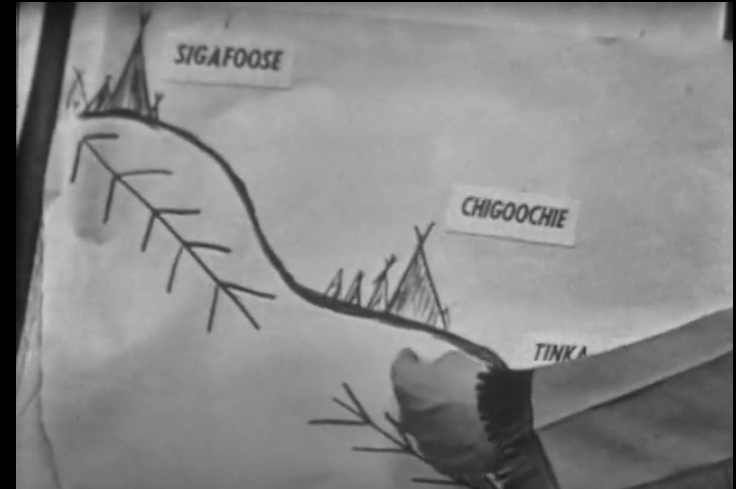What I watched: A 1950 episode of children’s puppet show Howdy Doody., created by Roger Muir. The series starred “Buffalo” Bob Smith as the host and voice of the puppets and Bob Keeshan as Clarabell, with additional voices by Dayton Allen, Rhoda Mann and Bill LeCornec (although I’m not sure who played this episode’s guest character). This episode was directed by Bob Rippen and written by Ed Kean. It aired on November 1 at 5:30 PM on NBC and is available to view on the Internet Archive.
What happened: After the customary opening song, Howdy regales us with “the Howdy Doody Rumba”, including a couple of culturally questionable “ay carumba”s. We then launch into this week’s mystery, as “Chief Chickapaw” was drawing a picture of his “Indian Reservation” and inadvertently revealed something. This leads to a tableau of the chief being held hostage by Buffalo Bob and Clarabell. Bob thinks the Chief was drawing a map of the Howdy Doody Circus instead, and his suspicions are soon confirmed.

The extremely European-sounding Chief says that he was drawing the picture as a gift, and only didn’t want to show it because it wasn’t ready. Bob seems to buy this completely. The Chief signs the picture with a “T” instead of a “C”, which gets Bob’s suspicions going again. Bob tries to relate him to the other Native American characters they’ve had on the show. This leads into another song on the piano, “The Friend Song.”
Chief says he needs a little more time to finish his work, which leads into today’s old time movie, which involves a couple of dudes trying to catch a horse while hanging from a harness. Chickapaw explains how his warpaint is very significant, which leads into Buffalo Bob encouraging kids to get the Howdy Doody colouring book, where kids can draw their own face on the last panel. Howdy appears with an unsettling-looking parrot puppet, and sings to encourage kids to get their parents to buy things.
The Chief is finished with his very simple drawing, and says that his tribe, the Chigoochies, were caught in a conflict between the Sigafoose and Tinka Tonka. Not sure these are historically accurate names. Apparently there’s also a princess with a magic necklace in there. Clarabell sprinkles water on the drawing to simulate the upcoming rainy season. The Chief ultimately decides he’s going to help “the Feather Man” and the Sigafooses, as it’s easier to attack downhill in the rain. He presents Bob and Howdy with a ceremonial necklace, but ends up giving it to Mr. Buster instead.
Bob goes over to the “Shoedoodle” to advertise an array of Poll-Parrot children’s shoes, including “really rugged he-man Oxford, like dad wears.” He reflects on the episode’s events, and finds it strange that the Chief gave beads to Mr. Buster. The camera pans down to find the Chief writing in his notebook, with Suspense organ music playing. What a gripping cliffhanger, a shame we’ll never see the ending.
What I thought: Look, I genuinely don’t go into these articles looking to condemn 73-year-old TV shows for being racially insensitive, because it’s a waste of time. But I don’t think you need to be a social justice warrior to be a little uncomfortable with the appearance of the nefarious “Chief Chickapaw” in Howdy Doody. The series seems to have created a whole cosmology of made-up “Indians”, rendering them as a kind of fantasy world. It makes The Lone Ranger look like Reservation Dogs.
The plot of the episode is that Chickenfoot is being suspicious but the credulous Bob and Howdy buy into everything he’s saying, believing he’s going to be friendly. This requires the Chief being shady in a way that will be detectable by small children, resulting in Howdy and Bob looking like total idiots. It’s an interesting tack, making the children’s show host an unreliable narrator, but it also has the effect of training kids to see Indigenous people as untrustworthy even if they seem to be benevolent.

But, as always, the main purpose of Howdy Doody is to sell shit to kids. At this point the ads and merchandise have metastasized to take over a big portion of the show. Howdy is largely separated from the main action, sitting at his piano to play songs from the recent record, also featured on Kukla, Fran, and Ollie. Today’s main sponsor, Poll Pocket Shoes, now has its own puppet and set, blending into the larger action.
Obviously every show on traditional television depends on advertising. As a medium, it exists to sell shit. But there’s something especially uncomfortable when Buffalo Bob urges young kids to ask their parents to buy them a particular model of shoe. Together with the Native American stuff, all of this makes this episode of Howdy Doody a very weird and somewhat insidious watch.
Coming up next: Kukla, Fran, and Ollie plan to put on a show for a visiting humourist.


















